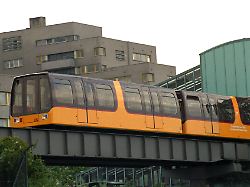Traffic researchers have doubts
Berlin Senate wants to go back to the future with a suspension railway
November 20, 2023, 6:50 p.m
In Berlin, streets and trains are full. A solution to the traffic volume has not been in sight for years. The CDU has an unconventional idea to master this: with the help of a magnetic levitation train. However, researchers doubt this. There were good reasons to rely on the subway.
Whether cable cars, drone taxis, the underground high-speed system Hyperloop or magnetic levitation trains – proposals for new concepts for public transport are coming up with great regularity in Germany. These ideas from federal or state politicians usually come to nothing. The attempt by the then Bavarian Prime Minister Edmund Stoiber to describe the advantages of a Transrapid from Munich Central Station to the airport is unforgettable. The project didn’t just fall by the wayside in terms of language.
The chairman of the CDU parliamentary group in the Berlin House of Representatives, Dirk Stettner, has now brought up the idea of building a magnetic levitation train for the capital. There should already be an agreement with the coalition partner SPD. Stettner argued that the routes required for this could be built much faster and cheaper than, for example, new subway lines. Another advantage, not least in view of the shortage of skilled workers at the Berlin local transport provider BVG: magnetic levitation trains are usually driverless. It remained unclear exactly where such a route could lead through the city. The schedule also remained unclear.
Berlin has already used magnetic levitation trains
In fact, there was already a maglev train in the capital. In the 1980s, the so-called M-Bahn ran from Gleisdreieck in Berlin-Kreuzberg via the Landwehrkanal and the Bernburger Straße station to Kemperplatz near Potsdamer Platz. Started as an experiment in 1984, it ran regularly from 1989 to 1991. After reunification, the country quickly ended the project and instead focused on expanding the subway network.
From the perspective of traffic researcher Andreas Knie, this was the right decision – and the arguments against a maglev train are still valid. “Magnetic levitation trains are high-performance mass transport that take a lot of people from A to B at the same time,” says the head of the Digital Mobility research group at the Berlin Science Center for Social Research. “That would have been a good idea for Berlin in the 20s, 30s or 40s, but not for Berlin today.”
The city has become more diverse and fragmented, says Knie. The existing means of mass transport – subway, S-Bahn and tram – are completely sufficient for this transport, emphasizes Knie. “The idea of building a completely new mode of transport in a highly dense, highly sealed city is out of date and simply pointless.” The suspicion arises that the government faction wants to use the proposal to distract from the really important problems of Berlin’s transport policy – above all the conflict surrounding the division of public street space.
BUND complains about the mockery of climate protectors
Even harsher criticism came from the Berlin regional association in the Association for the Environment and Nature Conservation (BUND). In particular, the proposal to finance the magnetic railway from Berlin’s special climate fund is “an absolute mockery of all people who seriously want to advance climate protection quickly,” said the association. “The climate crisis is too threatening to be dealt with like a fun party. Fantasy projects made of concrete make no contribution to climate protection goals.”
In principle, magnetic levitation trains have a good reputation. They are not driven by motors, but by magnetic fields along the route. They also don’t have wheels, but rather float a few centimeters above the rail. Maglev trains are considered fast, quiet and efficient. The technology has been around for decades. The best-known transport system of this type in Germany is the Transrapid, developed in this country by Siemens and Thyssenkrupp. However, it is not used anywhere in Germany.
This is also due to the tragic story: In 2006, a Transrapid accident occurred on a test route in Emsland. At around 170 kilometers per hour and with more than 30 passengers on board, the train raced into a maintenance vehicle on the route. 23 people died. According to transport researcher Knie, there are also other reasons why the technology has not become established in Germany: “Maglev trains as a means of transport only make sense over distances of several hundred kilometers,” he says. “That always leads to problems in a highly densely populated country like Germany. Germany is the wrong place for that.”
Suspension railways an idea for Europe
In Western Europe and most industrialized countries in particular, the existing train infrastructure has been developed to such an extent that a completely new concept with magnetic levitation trains makes little sense. Especially since modern high-speed trains are now quite competitive in terms of speed. Magnetic levitation trains, on the other hand, could be considered in planning for trans-European rail traffic, especially towards Eastern Europe. “Whether to Warsaw, Kiev or, at some point, Moscow again: Long-distance transport technology makes sense wherever the rail infrastructure is not good but where we want to go,” says Knie.
Now it remains to be seen what will happen next in Berlin. There is neither a Senate resolution nor are there any specific funds earmarked for this in the current budget. However, the idea itself is not new. A route from the city center to the capital airport BER was also already under discussion. There are currently no publicly stated estimates in the capital as to whether this route could be completed within ten minutes, as was once planned in Munich.
